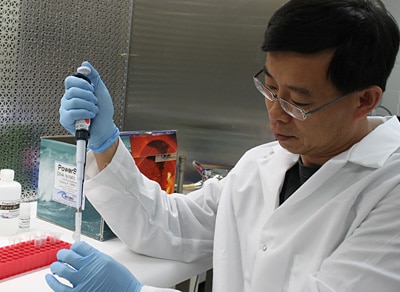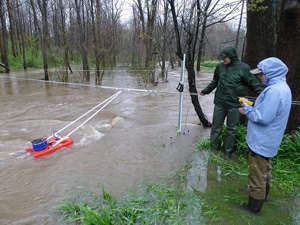
Jinjun Kan, Ph.D., processes samples in his lab. Photo: Kay Dixon
Stroud™ Water Research Center and the University of Delaware have received a $475,000 grant from the U.S. Department of Agriculture to study how the enormous amount of particulate organic nitrogen transported downstream during intense storms contributes to the overall nitrogen load, and what then happens to all the particulate materials.
“It’s important to figure this out,” says Jinjun Kan, Ph.D., the microbial ecologist who leads the project at Stroud Center.
“Big storm events will deliver huge amounts of particulate materials into the fluvial network, which contributes significantly to the total amount of nutrients in freshwater streams and rivers.”
NUTRIENT LOADING AND DEGRADED WATER QUALITY DOWNSTREAM?
Previous studies have shown that large tropical storms like Irene and Lee in 2011 and Sandy in 2012 eroded large amounts of sediment and particulates and transported them into and through waterways.
On a sunny day, when relatively clear water meanders downstream in gentle, shallow riffles, nitrogen is transported — mostly in a dissolved, or soluble, state where local colonies of bacteria feast upon it.
But during intense storms, streams can look like Mother Nature flushed her toilet.
“You get a sudden, dramatic increase in water volume and turbidity where many kinds of organic particles — likely from soil sediments — flush downstream all the way to the ocean,” says Kan.
“Along the way, these particulate materials may deposit onto the streambeds or adjacent to stream banks, where a suite of microorganisms facilitate the nitrogen cycling and pump nitrogen back into the environment. Particulate nitrogen transforms to soluble forms that get into the estuary eventually and increase nutrient loading, causing algae blooms that could degrade water quality or cause fish kills.”
A LITTLE-STUDIED PART OF THE NITROGEN CYCLE

Dave Montgomery and Sara Damiano measure flow rate in White Clay Creek during a storm.
The researchers also will study the release of greenhouse gases such as carbon dioxide, methane and nitrous oxide, and their significance for regional and global carbon and nitrogen cycles.
Kan and his research group will incubate sediment samples taken from different locations and time periods in the study area to assess carbon and nitrogen leaching into the stream waters, the proportion released into the air, and what type of microbes and processes are involved in carbon and nitrogen transformations.
The nitrogen cycle is one of the most studied processes in the scientific world, and lots of research has been done on dissolved forms of nitrogen.
“But not many studies have focused on how particulate, or insoluble, forms contribute to the total nitrogen load, because it’s a dynamic process that’s difficult to measure,” says Kan.
Collaborating with Kan are Shreeram Inamdar, professor in the Department of Plant and Soil Sciences at the University of Delaware College of Agriculture and Natural Resources and director of the water science and policy graduate program, and Rodrigo Vargas, assistant professor of plant and soil sciences.
The study will be conducted in a section of forested watershed in northern Maryland where Inamdar and Vargas have previously installed numerous water-monitoring instruments and collected extensive baseline data.



